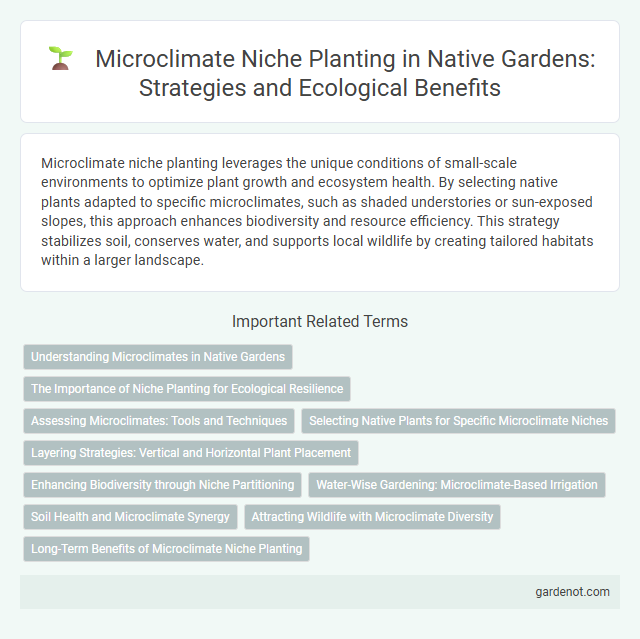Microclimate niche planting leverages the unique conditions of small-scale environments to optimize plant growth and ecosystem health. By selecting native plants adapted to specific microclimates, such as shaded understories or sun-exposed slopes, this approach enhances biodiversity and resource efficiency. This strategy stabilizes soil, conserves water, and supports local wildlife by creating tailored habitats within a larger landscape.
Understanding Microclimates in Native Gardens
Microclimate niche planting in native gardens involves identifying specific areas with unique light, moisture, and temperature conditions that support diverse native species. Recognizing these microclimates enables gardeners to optimize plant health and biodiversity by matching species to their preferred environmental conditions. Success in native planting requires detailed observation of sun exposure, soil types, and wind patterns to create sustainable microhabitats.
The Importance of Niche Planting for Ecological Resilience
Microclimate niche planting enhances ecological resilience by creating tailored habitats that support diverse native species adapted to specific environmental conditions. This approach stabilizes local ecosystems by improving soil health, conserving water, and providing refuge for pollinators and wildlife. Targeting microclimates within larger landscapes promotes biodiversity and strengthens natural systems against climate change impacts.
Assessing Microclimates: Tools and Techniques
Microclimate niche planting requires precise assessment through tools such as infrared thermometers, soil moisture sensors, and light meters to measure temperature variations, humidity levels, and sunlight exposure. Geographic information systems (GIS) and remote sensing technologies provide spatial data crucial for identifying microhabitats within larger ecosystems. Combining these techniques ensures optimal plant species selection tailored to specific microenvironmental conditions for enhanced growth and sustainability.
Selecting Native Plants for Specific Microclimate Niches
Selecting native plants for specific microclimate niches enhances garden resilience by matching species to localized temperature, moisture, and sunlight conditions. For shaded, moist areas, plants like ferns and wild ginger thrive, while sun-exposed, dry niches support species such as lavender and prairie grasses. Understanding soil type and humidity levels further refines plant choice, ensuring optimal growth and biodiversity within microhabitats.
Layering Strategies: Vertical and Horizontal Plant Placement
Microclimate niche planting leverages vertical and horizontal layering strategies to optimize native plant growth by creating diverse habitats that enhance sunlight exposure, moisture retention, and wind protection. Vertical layers consist of canopy trees, understory shrubs, and ground cover, while horizontal layers distribute plants spatially to mimic natural ecosystems and increase biodiversity. This strategic placement fosters resilient microclimates, promoting sustainable native plant communities and improving ecosystem functions.
Enhancing Biodiversity through Niche Partitioning
Microclimate niche planting enhances biodiversity by creating distinct environmental conditions that support a variety of native species with specialized habitat needs. This approach promotes niche partitioning, allowing different plants to coexist by exploiting unique microhabitats such as varying light, moisture, and soil conditions. By tailoring plant selection to these microclimate niches, ecosystems achieve greater species richness and resilience, fostering balanced ecological interactions.
Water-Wise Gardening: Microclimate-Based Irrigation
Microclimate niche planting in native gardening leverages water-wise irrigation techniques by tailoring watering schedules to specific microclimate conditions, reducing water waste and promoting plant health. Selecting drought-tolerant native species adapted to local microclimates enhances water efficiency and supports ecosystem resilience. Implementing drip irrigation and mulching within shaded or sheltered zones further conserves moisture and optimizes root hydration.
Soil Health and Microclimate Synergy
Microclimate niche planting enhances soil health by promoting diverse root systems that improve soil structure and nutrient cycling. Native plants create microclimate synergy by moderating temperature fluctuations and retaining moisture, which supports beneficial microbial activity. This integrated approach boosts ecosystem resilience, fostering sustainable growth and biodiversity in planted areas.
Attracting Wildlife with Microclimate Diversity
Microclimate niche planting leverages the subtle variations in temperature, humidity, and sunlight within a garden to create diverse habitats that attract a wide range of wildlife. Native plants selected for specific microclimates provide essential food, shelter, and breeding sites for pollinators, birds, and beneficial insects throughout the year. This targeted approach enhances biodiversity by supporting species with varied habitat preferences and promoting ecosystem resilience.
Long-Term Benefits of Microclimate Niche Planting
Microclimate niche planting enhances the resilience of native ecosystems by creating optimal conditions for plant growth, reducing water usage, and minimizing maintenance needs. This targeted approach supports biodiversity by fostering habitats conducive to native wildlife and pollinators, which contributes to a balanced ecological network. Over time, microclimate niche planting also improves soil health through natural nutrient cycling, leading to sustainable landscape stability and carbon sequestration.
Microclimate niche planting Infographic

 gardenot.com
gardenot.com